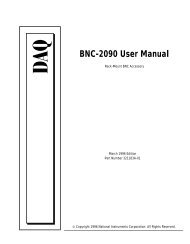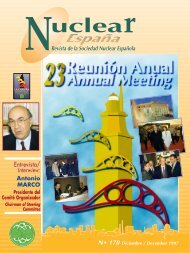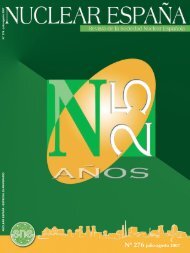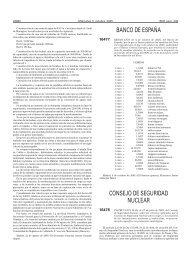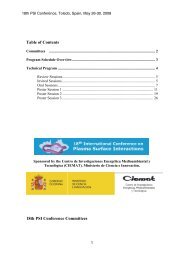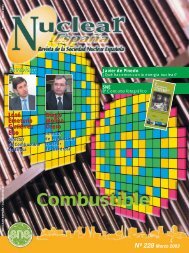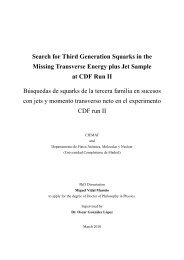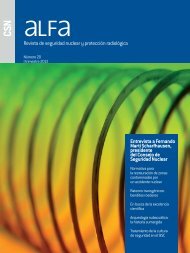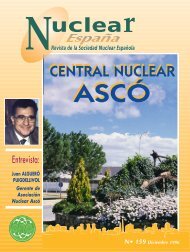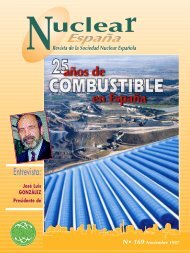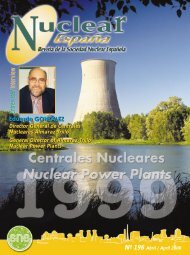Create successful ePaper yourself
Turn your PDF publications into a flip-book with our unique Google optimized e-Paper software.
de forma automática (disparos) (equivalentesa 1,3 por reactor) y 1 fueefectuada de acuerdo con los procedimientosde operación de parada.Con ello el valor medio anual alcanzael valor de 1,4 paradas por reactor yaño.Puede afirmarse que las nueve unidadesque integran el parque nuclearespañol han tenido en 1995 un excelentecomportamiento en cuanto a seguridad,disponibilidad y costes, manteniendola línea de los añospasados. Así, su seguridad de funcionamientoha sido calificada repetidamentede satisfactoria por la autoridadregulatoria nuclear española y ladisponibilidad media que he indicadoha sido similar al de otros años en losque el parque nuclear español se hasituado en el tercer o cuarto puestodel “ranking” mundial según dicho parámetro.En cuanto al coste de operacióny mantenimiento, el valor medioes equivalente a 1 centavo de dólarpor kWh, cifra que está en línea conla de las centrales más eficientes delmundo y en las que también se da, aligual que en las españolas, esa doblecondición de bajo coste y alta disponibilidad.Esto es importante subrayarlo:las centrales nucleares que mejorfuncionan son las que registran menorescostes.Como acontecimientos más destacadosdel parque nuclear español en1995 figuran la ya comentada vueltaa su funcionamiento normal de lacentral de José Cabrera, después deun período de parada de más de unaño debido a la inspección y reparaciónde las grietas en varias penetracionesde la tapa de la vasija, y elcambio de los generadores de vaporen la central de Ascó I. Esta operaciónse realizará en las centrales deAscó 2 y Almaraz 1 durante este añode 1996 y en la central de Almaraz 2en 1977.También he citado el aumento de potenciade 17 MW eléctricos conseguidopor Ascó 1 tras el cambio de generadoresde vapor, aumento que podrállegar en una segunda fase hasta los38 MW. Otras centrales nucleares tienentambién previsto conseguir aumentosde potencia en los próximosaños -de forma similar a como se estárealizando en otros países- con unhorizonte máximo de unos 900 MWeléctricos, es decir, un 12% más sobrela potencia original de 7.400 MW.Debe destacarse, también, que elComité de Energía Nuclear de UNE-SA aprobó a finales de 1995 un PlanEstratégico -conocido como Plan deActuaciones Conjuntas de lasCentrales Nucleares- que posteriormenteha recibido asimismo la aprobaciónde las instancias superioresde UNESA.El Plan de Actuaciones Conjuntas esun gran paso en el trabajo conjuntoque desde hace más de 10 años vienenrealizando las centrales nuclearesespañolas, haciendo un uso máseficaz de los recursos y posibilitandola complementariedad y la sinergia.El Plan pretende establecer actuacionesen temas de interés para la mayoríade las centrales que serán llevadasa cabo en los próximos diezaños, con especial acento en los cincoprimeros. Se trata de un conjuntode 50 actuaciones pertenecientes adiferentes áreas (Seguridad, Modernización,Mantenimiento, Residuos,Costes, etc), de las cuales se han seleccionadocomo prioritarias 12, talescomo Gestión de Vida Útil, Aumentode Potencia, Modernización de laInstrumentación y Control, Aplicaciónde los Análisis Probabilistas deSeguridad, etc. Próximamente, el 22de Febrero, se hará una presentaciónen UNESA de los detalles de estePlan.LAS ACTIVIDADES EN MATERIADE ENERGÍA <strong>NUCLEAR</strong>Quisiera dedicar ahora unas palabrasa las actividades nucleares más significativasdesarrolladas en el marco decoordinación de UNESA durante elpasado año.Como es sabido, en UNESA las actividadesen materia de energía nuclearson coordinadas por el Comité deEnergía Nuclear (CEN) que, como órganocompetente en estas materias,informa al Comité de Directores delas empresas eléctricas. Para el desarrollode sus actividades, el CENcuenta con el apoyo de la DirecciónNuclear de UNESA.El Comité de Energía Nuclear estácompuesto por los responsables máximosde las empresas eléctricas enel área nuclear así como por losDirectores/Gerentes de las centralesnucleares. Su misión es coordinar laexplotación de las centrales de formaque se consiga un funcionamiento excelente.Tras los pequeños cambiosintroducidos recientemente, el Comitédesarrolla sus actividades a través de4 Comisiones temáticas (Explotación,Combustible, Residuos y Desmantelamientoy ComunicaciónNuclear) y tres Grupos Ad-hoc (deAdministradores de las centrales nucleares,de Análisis Probabilistas deSeguridad y de Protección Radiológicay Sanitaria).El Comité de Energía Nuclear mantienereuniones con una periodicidadmensual para tratar de la dirección,supervisión y seguimiento de los trabajosde las Comisiones y Gruposque dependen de él, adoptando lasdecisiones oportunas al respecto.También se ocupa de la preparaciónde las reuniones del Comité deEnlace CSN-Sector Eléctrico, de lasComisiones Paritarias con ENUSA yENRESA y de la participación delSector Eléctrico en organismos internacionalescompetentes en materiaAs pointed out above, there was a slight increase innuclear generation during 1995, attributablefundamentally to the fact that the José Cabrera (Zorita)plant returned to service. Production was distributedfairly uniformly throughout the year, with Decemberproviding a peak of 5,391 million kWh, representing aload factor of 97.7%.As in previous years, Spain’s nuclear power plantscontributed approximately a third of the country’s totalelectricity generation.These high levels of production have gone hand in handwith excellent load and availability factors, whichreached an annual total of 85.5% and 88.2%respectively for the plants overall. The scheduled andnon-scheduled unavailability factors were 11.0% and1.8%, respectively.As regards non-scheduled plant shutdowns, 1995 endedwith a total number of 13. Of these, 12 were automatic(scrams) (equivalent to 1.3 per reactor) and 1 wasperformed in accordance with shutdown procedures.This gives an average annual value of 1.4 scrams perreactor-year.It can be certainly said that the nine units that make upSpain’s nuclear generation capacity have behavedexcellently as regards safety, availability and costs, thuscontinuing their performance in previous years. In thiscontext, the operational safety of the plants has beenrepeatedly described as satisfactory by the Spanishregulatory authority, and the average availability towhich I have already referred has been similar to that ofprevious years, in which the Spanish plants ranked thirdor fourth in the world list for this parameter. Operationand maintenance costs showed an average valueequivalent to 1 cent of US dollar per kWh, a figure whichis in line with the world’s most efficient plants which, liketheir Spanish counterparts, bring together low costs andhigh levels of availability. It is important to underline this:the best performing nuclear power plants are thosewhich show the lowest costs.The most outstanding events occurring in the Spanishplants during 1995 have been the return to normaloperation of the José Cabrera plant following an outageof more than one year for the inspection and repair ofcracks in several of the reactor vessel headpenetrations, and the replacement of the steamgenerators at Ascó 1. This operation is to be performedalso at Ascó 2 and Almaraz 1 during 1996, and atAlmaraz 2 in 1997.I have referred also to the 17 MWe uprating achieved byAscó 1 following replacement of the plant’s steamgenerators, an increase which may reach up to 38 MWduring the second phase. Other nuclear power plantsalso foresee power increases in forthcoming years - asis the case in other countries - the maximum figurecontemplated being some 900 MWe, i.e. 12% more thanthe original power level of 7,400 MW.Mention should be made also of the Strategic Plan -known as the Joint Action Plan for the Nuclear PowerPlants - which was approved by the UNESA NuclearEnergy Committee at the end of 1995, and which hassubsequently received the approval of UNESA topmanagement.The Joint Action Plan is a major step forward in theefforts that the Spanish nuclear power plants havetogether been making for more than 10 years in relationto more efficient use of resources and increasing levelsof synergy and complementary action.The Plan aims to bring about action in areas of interest forthe majority of the plants, this covering a period of tenyears with special emphasis on the next five. This actionconsists of a series of 50 projects in different areas(Safety, Modernization, Maintenance, Wastes, Costs,etc.) of which 12 – dealing with Lifetime Management,Uprating, Modernization of Instrumentation and Control,the Application of Probabilistic Safety Assessments, etc. –have been identified as priority issues. The details of thisPlan will be presented at UNESA on 22nd February next.ACTIVITIES IN THE FIELD OF <strong>NUCLEAR</strong> ENERGYI should like now to briefly touch on the most significantactivities carried out in relation to nuclear energy duringthis last year within the framework for coordinationprovided by UNESA.As is known, nuclear energy-related activities arecoordinated at UNESA by the Nuclear Energy Committee(NEC) which, as the competent body for such issues,reports to the electricity utilities’ Committee of GeneralManagers. In performing its functions, the NEC receivessupport from the UNESA Nuclear Directorate.The Nuclear Energy Committee is made up of theelectricity utilities’ top managers for nuclear affairs and bythe Directors of the nuclear plants themselves. Themission of the Committee is to coordinate operation of theplants with a view to ensuring excellence. Following theminor changes made recently, the Committee carries outits activities through four subject-specific Commissions



